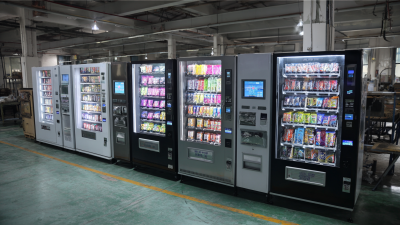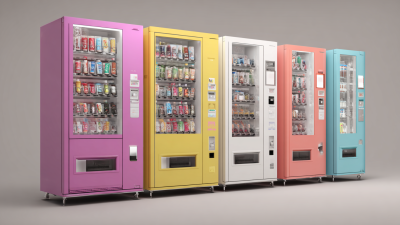Challenges Faced by Businesses When Implementing Vending Machine Solutions
In the fast-paced world of modern commerce, businesses continually seek innovative solutions to enhance customer experience and streamline operations. One such solution gaining traction is the implementation of vending machine systems. These automated kiosks offer a convenient way to provide products and services to customers around the clock, yet their integration into existing business frameworks can pose several challenges. From selecting the right locations and managing inventory to ensuring machine reliability and addressing customer service concerns, the journey to successful vending machine deployment is filled with hurdles. In this blog, we will explore the common obstacles businesses face when adopting vending machine solutions and discuss strategies to overcome these challenges, ultimately unlocking the full potential of this increasingly popular service model.

Challenges in Selecting the Right Vending Machine Technology for Business Needs
When businesses decide to integrate vending machine solutions, selecting the right technology can be a daunting task. With a wide range of options available—from traditional machines to smart vending solutions equipped with touch screens and cashless payment systems—companies must carefully consider their specific needs. Factors such as target audience, product selection, and location play critical roles in determining which technology will provide the best return on investment.
Tip 1: Conduct thorough research on various vending machine technologies. This includes understanding the features of each option and how they align with your business goals. For instance, if your customer base prefers cashless payment, investing in machines with modern payment options could enhance user experience and sales.
Tip 2: Evaluate the space where the vending machine will be placed. The size and design of the machine should fit both the physical environment and the aesthetic of the location. Considerations such as visibility, accessibility, and foot traffic can significantly influence the machine’s success. Selecting the right model that complements the space can attract more customers.
Integration Issues with Existing Payment Systems and Infrastructure
 Integrating vending machine solutions into existing payment systems and infrastructure presents significant challenges for businesses. A recent report by the National Automatic Merchandising Association (NAMA) highlighted that about 40% of businesses encounter compatibility issues when trying to link modern vending machines with legacy payment methods. This is particularly concerning as consumer preferences increasingly lean towards cashless transactions, with mobile payments expected to make up 50% of all vending-related purchases by 2025.
Integrating vending machine solutions into existing payment systems and infrastructure presents significant challenges for businesses. A recent report by the National Automatic Merchandising Association (NAMA) highlighted that about 40% of businesses encounter compatibility issues when trying to link modern vending machines with legacy payment methods. This is particularly concerning as consumer preferences increasingly lean towards cashless transactions, with mobile payments expected to make up 50% of all vending-related purchases by 2025.
Furthermore, according to a study by IBISWorld, approximately 35% of vending operators report difficulties in adopting new technologies due to outdated infrastructure. This gap not only impacts customer satisfaction but also limits the ability to leverage advanced features such as inventory tracking and personalized marketing strategies. As businesses strive to offer seamless payment experiences, the integration of vending machines with their existing systems becomes a crucial investment that requires careful planning and execution.
Navigating Compliance and Regulatory Challenges in Vending Operations
Navigating the compliance and regulatory landscape is one of the most pressing challenges for businesses implementing vending machine solutions. With the increasing prevalence of technologies like facial recognition embedded in various everyday activities, the scrutiny on data privacy has intensified. Companies must ensure that their vending machines not only meet local health and safety regulations but also comply with strict data protection laws. For instance, with regulations around the use of facial recognition technology gaining momentum, businesses need to consider how they handle consumer data and whether they have the necessary consent mechanisms in place.
Moreover, as businesses look to innovate with vending technologies, they must also contend with the ramifications of broader regulatory changes in their operating environments. The shift towards digital assets and the growing importance of compliance within fintech sectors illustrate a trend where operational practices must evolve in tandem with technological advancements. This dynamic is particularly relevant in vending operations that integrate payment systems reliant on personal data, making it critical for companies to stay ahead of legal requirements while delivering user-friendly experiences. As the market continues to grow, adapting to these compliance challenges will be key for sustained success.
Understanding Consumer Preferences and Trends in Vending Machine Choices
Understanding consumer preferences and trends is crucial for businesses looking to implement vending machine solutions effectively. The vending machine market is rapidly evolving, with a noticeable shift towards healthier options. As consumers become more health-conscious, they are seeking zero-calorie beverages and flavored milk as convenient and guilt-free choices. This trend is driving the growth of the sugar-free beverage market, which is expected to expand significantly by 2033.
Tips for businesses: To cater to these evolving consumer preferences, consider incorporating healthy beverage options in your vending machines. Stocking items such as flavored coconut water or sugar-free drinks can attract health-conscious customers. Additionally, offering variety through different packaging options, like cans and pouches, can enhance convenience and appeal.
Moreover, understanding regional insights can further refine your vending machine's product offerings. Different areas may exhibit unique preferences—urban consumers might favor on-the-go products, while rural areas may prefer traditional options. By leveraging regional data, businesses can effectively tailor their vending solutions to meet local demands and drive sales.

Balancing Cost and Profitability in Vending Machine Implementation Strategies
Implementing vending machine solutions presents unique challenges for businesses, particularly when it comes to balancing cost and profitability. As noted in a recent report by IBISWorld, the vending machine industry has seen an average annual growth rate of 3.6% from 2017 to 2022, indicating a lucrative market. However, with the cost of machines ranging from $3,000 to $10,000 depending on features and capabilities, businesses must carefully assess their initial investments. Additionally, ongoing expenses such as inventory management, maintenance, and location rent can quickly accumulate, putting pressure on profit margins.
To navigate these financial hurdles, businesses should consider data-driven strategies for optimizing their vending machine operations. A survey by the National Automatic Merchandising Association reveals that about 45% of vending operators utilize advanced telemetry systems to monitor sales and inventory in real-time, enabling them to make informed decisions about restocking and product offerings. This proactive approach not only helps in reducing waste but also aligns inventory with customer preferences, ultimately driving profitability. By strategically balancing costs while leveraging technology, businesses can effectively harness the potential of vending machines to enhance their bottom line.
Related Posts
-

Unmatched Quality from Leading Chinese Factories for Your Vending Machine Needs
-

Exploring Innovative Alternatives to the Best Vending Machine for Your Business Needs
-

Maximizing Cost Efficiency Through Exceptional After Sales Support for Free Vending Machines
-

Understanding the Snack Machine Business and Its Unique Opportunities
-

China's Premium Manufacturing: Your Source for the Best Buy Vending Machines Worldwide
-

Quality Vending Machine Solutions from China for a Global Market